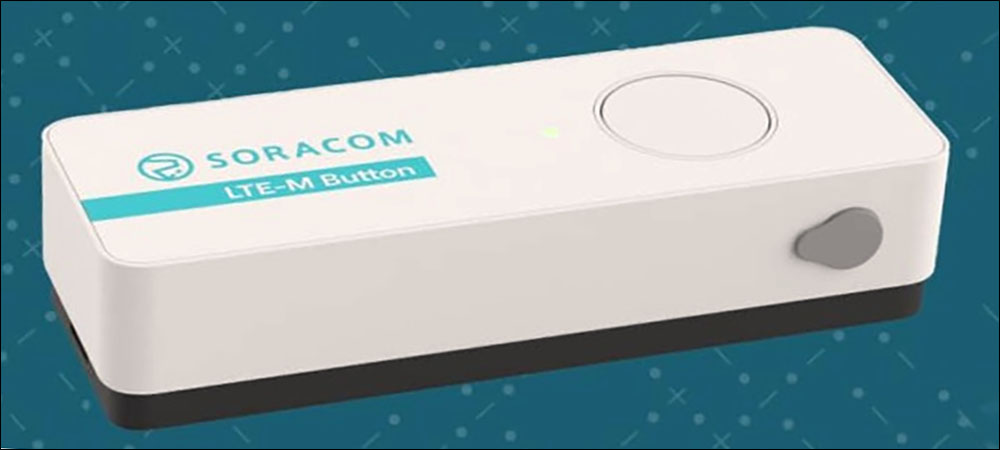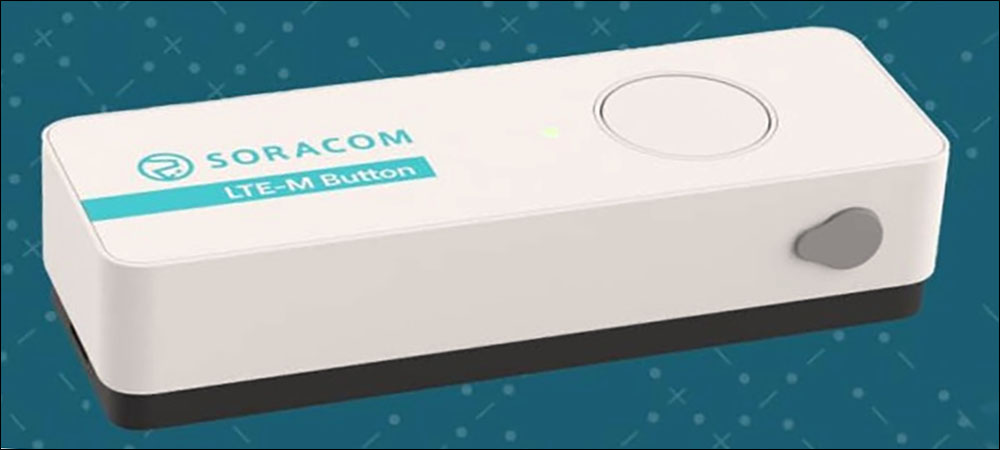RFID Journal LIVE! 2023 will feature end-user companies discussing IoT technologies’ use in various industries, as well as exhibitors offering tagging solutions for multiple applications. To learn more, visit the event’s website.
Global Internet of Things (IoT) company Soracom has joined forces with IoT services provider UnaBiz to develop a device the companies call the LTE-M Button, which is intended to make IoT connectivity as simple as pressing a button. The device employs Soracom’s electronic subscriber identity module (eSIM) technology and cloud-native smart connectivity platform to automatically send data to the cloud each time the button is pressed. The product is being jointly launched by Soracom and Unabiz.
The LTE-M Button is intended for device manufacturers and end users, who can configure the button to trigger functions on Amazon Web Services (AWS), Microsoft Azure or Google Cloud without requiring data management on a dedicated server. The system was designed for simplicity, according to Kenta Yasukawa, Soracom’s cofounder and CTO. Versions of the button have been used by manufacturers, agricultural companies and utilities in Japan for years, and distributors are now releasing it in France, Germany, Italy, the Netherlands, Portugal, Singapore, Spain, Taiwan, Thailand, the United Kingdom and the United States as well.

The LTE-M Button
UnaBiz has offered solutions in the past leveraging Soracom’s eSIM-based connectivity. The IoT connectivity is being built into various devices for fast, easy connection in a variety of settings. The two companies, Yasukawa says, “have worked together to fulfill customer needs whenever customers want some custom hardware [IoT] project.” Deployments have been carried out in Japan, including a network-control unit for an energy company’s wireless meters. “They design the hardware together with us, and we integrated that with our platform,” he states.
Leveraging Sigfox, LP-WAN and LTE
Traditionally, adding IoT functionality to assets or equipment has required integration and a potentially complex deployment. Additionally, the regular transmission of data can be costly and taxing for battery power. “We shared a similar vision for a simple, easy way to get started in IoT,” Yasukawa says, “and we worked together to design this LTE-M Button.” Soracom and UnaBiz developed the LTE-M Button so that a single message could be sent only when the button was pressed. Soracom offers its eSIM and cellular connectivity for the LTE-M Button, and also for SEACOM’s branded solutions.
UnaBiz, the parent company of Sigfox, builds solutions that employ Sigfox-standard transmissions, as well LP-WAN and other technologies. The company offers software development, its own cloud-based platform and the necessary IoT hardware. Soracom’s eSIM technology, meanwhile, transmits data via either LTE-M or another wireless network, depending on a customer’s particular needs and the wireless availability. While IoT deployments can seem complex based on such needs, the companies report, the button device is designed for simplicity.
When a user clicks a button, it connects to the cellular network and sends a message to Soracom’s management software, announcing that action. “That’s it,” Yasukawa says, adding that the LTE-M Button is low-cost, with a low footprint that does not consume much energy. Depending on the volume of devices purchased, the price averages only tens of dollars, and users would pay a monthly fee for connectivity. Because the device only transmits when the button is pressed, the amount of power required is minimal.
How the IoT Solution Works
Users would need to set up system logic to associate the click with a specific action. That could be anything from triggering an order for pizza at a particular store, to triggering a new setting in assembly equipment. To accomplish this, individuals would select their cloud service of choice, such as AWS, Azure or Google Cloud, then apply a code that would link a configured action based on the button’s ID number. The system, Yasukawa says, “allows you to deploy a piece of code that you write to the cloud environment, and you can just execute that function anytime you want.”

Kenta Yasukawa
That’s an alternative to building the entire application software with a dedicated virtual server, which might be needed with typical IoT deployments. While that process works well for complex solutions, Yasukawa notes, the LTE-M Button is dedicated to small event reporting. Once the code has been written, the device is ready for use. It comes with a battery-based power source, but it remains dormant until the button is pressed. Once that happens, the button prompts the eSIM to transmit the device’s unique ID number to the server, where the code-based instructions are stored. The system then prompts the associated action.
A manufacturing company in Japan is using the device with two buttons, each dedicated to a different instruction. The device is mounted at workstations around the company’s assembly site. When workers need to pause a conveyor, they can press one of the buttons. The software receives the LTE-M transmission and identifies the workstation based on the device’s ID. It then sends a prompt to the company’s equipment programmable logical controllers to stop movement for that station’s conveyor. When workers are ready to resume the factory automation line, they can press the second button. The data transmission prompts the appropriate response, causing the conveyor to restart.
The manufacturer, which has asked to remain unnamed, implemented the cloud logic itself. The solution, Yasukawa says, offers an alternative that is more mobile and lower in cost than mechanical switches. Each switch used, for purposes such as powering equipment on and off, can require additional cabling, and it cannot be accessed remotely. For instance, managers could not view when machines were switched on or off, and they were unable to adjust the prompts when assembly requirements changed. “So it’s not always static,” he explains. “Depending on the product or the station, they may need to arrange it differently.”
Planning Additional Use Cases
After several years of Japanese deployments, Soracom and Unibiz have created a global version of the product, which Yasukawa says has gained interest from North American hospitals and for other use cases. The LTE-M Button could be a simple way for patients or their visitors to request help in a hospital room, he notes. The device could also be sent home with patients, enabling them to remotely connect to the appropriate caregivers or healthcare personnel by pressing the button if they require assistance.
Another application is in the agriculture industry. Such use cases are already being addressed in Japan, according to Yasukawa, to identify if a wild animal enters a vulnerable field. For instance, he says, “Some wild animals show up and eat the vegetables and fruits” being grown by food producers. Businesses have deployed traps to capture nuisance grazers, such as deer or hogs, but they needed to know when the animals were caught. The button can be connected to an external sensor, so this version leverages a magnetic field sensor to detect the opening or closing of a door.
No matter how the device is used, Yasukawa states, “We intentionally made it simple so that we can cover many different use cases. But once we identify some more complicated use cases, we can help to design the device or find a partner device to achieve more complicated scenarios. We consider it as an entry point for everybody to get started in using our platform and implementing some IoT use cases.” According to Yasukawa, the companies expect customers to be developers, technology providers and end users. The LTE-M Button stands on the learnings of past deployments, he says.
One solution that Soracom and UnaBiz have offered in Japan was for Nippon Gas Co. (NICIGAS). Launched in 2019, it comprises one million gas meters with wireless connectivity. Previously, meters had been manually read each month. The two companies developed Space Hotaru, a network-controlling unit that transmits gas-consumption data to the energy company’s central IoT platform, known as NICIGAS Stream. The firm found that the wireless meters could be deployed within less than five minutes, including the two minutes required to bind the devices to gas pipes. In the coming years, NICIGAS expects to use the system to collect data from more than a million users.
Key Takeaways:
- UnaBiz and Soracom have built a device designed to be as simple as pressing a button, enabling new IoT innovation.
- Individuals can use the LTE-M Button for anything from ordering a pizza to requesting medical attention, by pressing the button to trigger the cellular transmission of the specific action needed.


